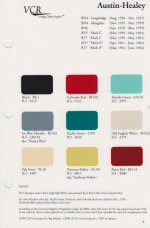Use PPG DP epoxy primers, they have a chemical bond life of up to seven days. Plenty of time to caulk once dried, then apply sanding primers or top coats ect. After the seven day period ( higher temps can shorten bond times) you would have to scuff and re apply the DP for the chemical bond ( as opposed to a sanded or scuffed mechanical bond). The chemical bond is much stronger and you will never have peeling of layers due to poor adhesion.
Heres what I do at the shop for the whole process...
Strip down to bare metal , I use aircraft brand stripper (low odor) for the alum parts, media blast ( like plastic for good metal sand for rust ,black beauty is too aggressive)or chemically strip all metal.
Sand with 320 or 400 to remove any errant specs of paint (this is for good panels)
CLEAN metal with PPG DX 579 metal cleaner (follow instructions and blow off/dry water immediately ) you should clean your sheetmetal as there really is a lot of gunk on the surface even if it is sanded and shiny,trust me !
Clean with DX 330 wax and grease remover, tack areas to be primed and prime with PPG DP epoxy ( I used DP 40 or DP 90 red or black as you can now see every little defect in the sheetmetal.
Pencil your areas to be fixed
Hammer/dolly/slap spoon out what you can ,this is for the little stuff, assuming all heavy metal bumping/welding is already done.
Plastic work ( if your old school.... lead work before primer : ) I use Evercoat products over the epoxy primer.( this is done to encapsulate the plastic body filler in the process) You ever strip paint to see lots of rusty metal under body putty ???
Use the Evercoat metal glaze as a finishing putty as needed.
I use a flat black spray can and mist the plastic filler to detect any areas that need further details ( sanding down the bodywork highlites the high /low spots) A MUST DO TRICK FOR PERFECTION
Next I use PPG high build primers for sanding primer. One coat for the next step, another chance for blending and sealing the plastic filler, use same process of misting areas, sand in a cross wise method to avoid too much removal in one area ( use the long flat sanding boards for large areas , smaller for small ect. AFS boards are the best.... PERIOD !!!
If satisfied with body work , one coat of thinned out sanding primer ( these are all catalized, NEVER lacquer based ), mist again and 400 DRY sand i dont like sludge every where.
If satisfied with panel now prep for sealer, DX 330 again for final wipedown ( there are also others that remove water based contaminates), I always use nitryl gloves and keep everything hospital clean anyway.
Tack down and seal with PPG DP epoxy thinned as a sealer, ready for your top coat , last chance I go around and do a final dust check with 400 wet/dry paper but sand DRY. Tack again and top coat.
Top coat is a whole other process too... I use flattening agent where appropriate for the original un polished enamel look, no super shiny engine bays guys !
Aluminum panels are same as steel for process but use the appropriate PPG alum. cleaners , you epoxy prime and then do your plastic work.
Following these methods will pretty much give you a long lasting body restoration, Ive NEVER had any rust come back or paint related problems due to prep work.
Carroll Phillips
Top Down Restorations Inc.

 Hi Guest!
Hi Guest!

 smilie in place of the real @
smilie in place of the real @
 Pretty Please - add it to our Events forum(s) and add to the calendar! >>
Pretty Please - add it to our Events forum(s) and add to the calendar! >> 

